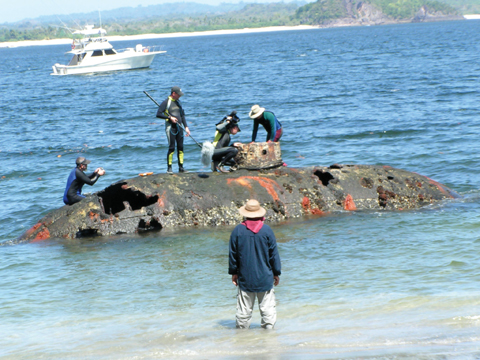| |
|
|

from the issue of April 27, 2006
|

| |
|
|
| |
Johnson lends expertise to sunken study

Retirement at sea

BY TROY FEDDERSON, UNIVERSITY COMMUNICATIONS
After a land-locked career in mechanical engineering, Don Johnson is taking his expertise to the high seas.

| | 
 
| | | EXPLORER EXPLORED - Don Johnson, retired UNL professor, wades out to the Sub Marine Explorer off the coast of Panama as other members of the research team examine the Civil War-era craft. Courtesy photo.

|
A retired professor of mechanical engineering, Johnson is working on a Central American project, studying a Civil War-era submarine off the coast of Panama. The sub - called the Sub Marine Explorer - is the sixth sunken craft Johnson has helped study. Other missions have led Johnson to study corrosion of the USS Arizona, the CSS Hunley, a B-29 in Lake Mead, a ferry in New York Harbor and a Japanese mini-sub.

"Everything I did at UNL was a lead-in to this work," Johnson said from his Arizona home. "I worked with Dr. Russ Nelson to develop the metallurgy program at UNL. And, that's how this whole thing kind of got started."

Johnson taught at UNL for 27 years, from 1963 to 1990. He spent his first year in retirement in Taiwan before returning to Lincoln. In 1997 he moved to Arizona to officially settle into retirement.

A year later - during a leisurely trip to Hawaii - Johnson started charting a water-laden retirement path.

"I was at Pearl Harbor and went to see the Arizona memorial," Johnson said. "I made a connection with the park service staff out there and asked if a metallurgical engineer had done any work on the USS Arizona.

"They told me they would like to talk about it."

The National Park Service put Johnson in touch with the Submerged Resources Center in Santa Fe, N.M. Founded to help study effects related to the creation of Lake Tao in the 1970s, the SRC is responsible for all underwater sites in the National Parks system.

Johnson learned how to dive and started studying the Arizona in 1998. UNL professor Bill Weins (who died in 2001) and John Maconson (one of Weins' former students) assisted Johnson initially.

 
| | NEW RESEARCH - Don Johnson performs a metalurgical test on the Sub Marine Explorer. In retirement, Johnson has maintained contact with UNL researchers. Courtesy photo.

| |
"What we do is a metallurgical analysis of the material in the submerged craft," Johnson said. "We study corrosion and the products that occur as a result of corrosion. Basically, we want to know what kind of condition the ship or submarine is in so we can predict how long it will last underwater or if it can be recovered and put into a museum."

Johnson continues to be committed to using UNL facilities for the ongoing research. Campus researchers who assist Johnson on projects are James Carr, professor of chemistry; Brent Wilson, assistant professor of mechanical engineering; and Jody Redepenning, associate professor of chemistry. Also, Wilson said eight students have helped with the research effort.

"The primary thing we look at is where iron comes in contact with concretion," Wilson said. "We go back to original assembly drawings and documents and are able to get a basic idea on how much iron has actually corroded away."

The project has built a better understanding of concretion - biological material and sediment that builds on sunken craft - and its corrosive effect on iron (buoyed by the ongoing study of the USS Arizona). The study is leading toward new, less invasive research methods.

"We are looking at different methods for assessment because a lot of these vessels are artifacts that we really don't want to cut into," Wilson said. "But, as we learn more about concretion, we are able to make advancements toward new techniques that are less destructive."

The UNL team has yet to study samples from the Sub Marine Explorer. Johnson said an initial assessment has been completed and project leaders are petitioning for additional funding from federal sources.

"We've completed a structural analysis, we've looked inside and done profiling of the sea floor around the sub to establish the stability of the site," Johnson said. "It's going to be a very interesting project because most of the metal is gone from one side of the sub, while the other side is about the same thickness as when it was built."

Johnson's sea-based research has earned him the George Heartstock award from the National Park Service. He will receive the honor May 12.

For Johnson, this new study area is an ideal way to spend retirement.

"It still amazes me that I'm doing this kind of work in retirement," said Johnson, who was too young to serve during World War II. "Doing work on these sites, particularly the USS Arizona, really means a lot to me. And, I'm pleased we've been able to maintain a connection with UNL."

Johnson's projects

Don Johnson has played a roll in six oceanic recovery/study efforts worldwide.

Those projects include:

Sub Marine Explorer
• A Civil War submarine sold for pearl retrieval in Panama (map at left).

USS Arizona
• A World War II battleship that sank during the attack on Pearl Harbor.

CSS Hunley
• A Civil War-era submarine recovered from Charleston Harbor in 2000.

B-29 Bomber
• A World War II bomber that rests at the bottom of Lake Mead.

Japanese Mini-Sub
• World War II era.

A Ferry
• Located in New York Harbor.
GO TO: ISSUE OF APRIL 27
NEWS HEADLINES FOR APRIL 27
Retirement at sea
New tower rings in end of semester
Saga of the Explorer
Biannual Gallup surveys gauge campus climate
FROM THE ARCHIVES
UCARE student learns nature, life lessons through camp experience
732428S35830X
|
|
|
|
|
|
|
|